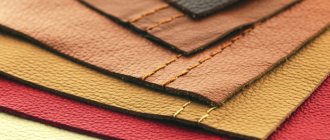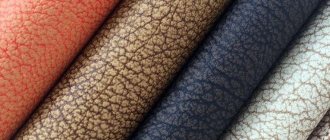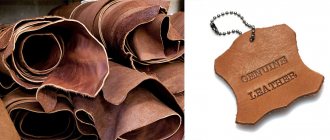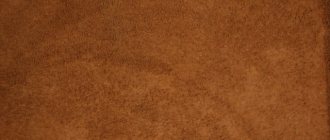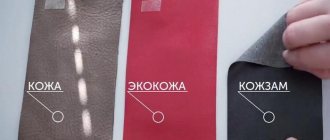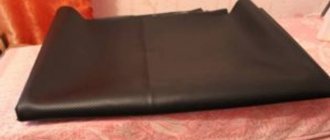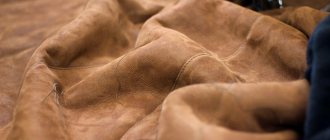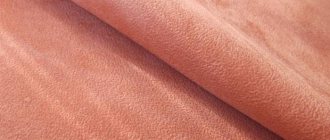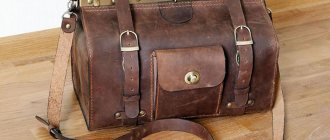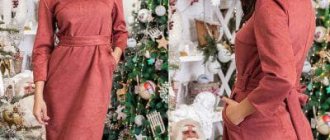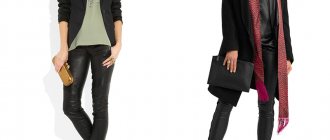Updated: 04/23/2021 15:26:24
Expert: Dina Shulman
The modern textile industry regularly uses the latest polymer materials. This is due to the fact that they are cheaper and often more beautiful than natural ones, and in terms of performance properties they are not inferior to the “original”. And this is especially evident in “leather” products.
Thus, clothes, shoes and accessories made of genuine leather are attractive and durable, but at the same time they are very expensive and are not suitable for convinced vegetarians and vegans. To correct these two problems, the textile industry often produces alternatives that retain both the design and quality of its predecessor. The most popular of them are eco-leather and artificial leather (leatherette).
In this article we will look at the difference between eco-leather and artificial leather – and what is better to use.
Eco leather
Eco-leather is a fairly new material that is highly technological. It is based on a polyurethane mass, but it is not the only substance in the structure. Eco-leather is a multi-layer material with very good performance properties.
So, eco-leather is characterized as follows:
- It is very wear resistant. Does not crumble, wear out or change color over time. Things made from it are resistant even to exposure to sunlight - they do not dry out or turn yellow under ultraviolet radiation;
- It is breathable. That is, it has a “breathing” effect. Thanks to this, the body under clothes does not sweat and does not “evaporate” at high temperatures. It is also useful in shoe making;
- It's elastic. Clothes and shoes “adjust” to the individual anatomical features of the wearer, without causing discomfort or unpleasant sensations. Of course, this is not a reason to take shoes two sizes smaller, but some sneakers or eco-leather sneakers will feel much more pleasant;
- It imitates the texture of natural leather. Does not differ from natural material either visually or to the touch. At the same time, it remains soft, which makes things made from it even more comfortable;
- It is hypoallergenic;
- It's inexpensive.
In addition to polyurethane or polypropylene itself, eco-leather also contains cotton or natural leather shavings. Polymers serve only as a connecting link. And most importantly, the polyurethane and polypropylene that make up eco-leather are environmentally friendly and do not cause irritation.
The only drawback of the polymer base is the relatively small operating temperature range. However, with everyday use it is unlikely to go beyond its limits. Polymers begin to be damaged at temperatures below -35 degrees or above 100 degrees.
All this provides a very wide range of applications for eco-leather. It is used to make clothing, upholstery of furniture and objects (for example, car seats), accessories and shoes. Eco-leather varieties vary in softness. For example, haberdashery is more rigid - so that handbags and purses keep their shape better.
So, let's summarize.
Advantages
- Realistic texture, almost indistinguishable from the natural version;
- Softness, firmness and elasticity. All this increases the reliability and durability of products;
- In the production of some types of eco-leather, natural crushed leather is used.
Flaws
- Easily scratched, especially when in contact with abrasives - including during cleaning or similar processing;
- Extremely unstable to cutting influences, easily pierced;
- The layered structure of eco-leather can lead to the fabric base being visible through defects on the top decorative film.
In general, eco-leather items are comfortable, practical and durable. The only complaint about this material is the insufficient strength of the top layer, due to which it is easily cut and scratched by abrasives. But if worn or used carefully, things made from eco-leather will please the eye for a long time.
By the way, eco-leather can be “modified” with various additives. That is, they distinguish cold-resistant, high-strength, heat-resistant, resistant to acids and alkalis, reinforced and several other varieties.
Features of fabric upholstery
Fabric upholstery adds warmth and comfort to the room. It is comfortable to wear in any weather - in the heat it does not stick to the body, and in the cold it does not freeze.
Texture and color
Furniture stores and factories offer a huge selection of fabric upholstery - different in texture, color, pattern and density. They are selected depending on the preferences and purpose of the sofa.
If you are looking for a material with a beautiful texture and patterns, pay attention to jacquard, flock or tapestry. They have voluminous patterns woven into the fabric, similar to neat embroidery.
Soft and pleasant to the touch - microfiber, velor and velvet. Durable fabrics include matting, and dirt-repellent fabrics include Scotchgard, Teflon, and Relax.
Now upholstery materials can be ordered in almost any color - it all depends on the capabilities of the manufacturer and your imagination.
Price
The price of textile upholstery varies from very cheap to incredibly expensive. It all depends on the density and quality of the fabric.
The most affordable upholstery materials are velor, flock and suede. They are not of such high quality, but they have a quite acceptable appearance, and furniture upholstered with them will fit perfectly into any modern interior.
Elite and expensive fabrics include relaxation and scotchgard. Less expensive, but high-quality fabrics are chenille and jacquard.
Even cheap fabrics can differ in price if the manufacturer has saved on the density and quality of the fabric. To ensure that the upholstery retains its neat appearance for many years, you should not save too much.
Wear resistance
Fabric upholstery begins to lose its appearance after 5-7 years. Fleecy fabrics wear out the fastest - velor, flock, velvet. Sofas made of tapestry and thermo-jacquard are afraid of direct sunlight, so over time they can lose their brightness in color. If there are pets in the house, chenille furniture will not last long - it can easily leave snags on it.
Universal materials that are not afraid of frequent cleanings, animal claws and direct sunlight - microfiber and scotch guard. With careful care, sofas made of velor, jacquard, chenille and Teflon-impregnated fabrics will last a long time.
Difficulties in care
The easiest way to care for stain-resistant fabrics is with impregnations - relaxation and scotchgard. Simply wipe the upholstery with a slightly damp cloth.
The rest of the fabrics are about the same in care. Most stains can be removed with a soap solution or special chemicals, but there are also capricious fabrics. Tapestry upholstery should be cleaned only with a dry method - with a vacuum cleaner, brush or special foam. Pile fabrics, on the contrary, should not be vacuumed or cleaned with a hard brush, as the pile may be damaged.
Faux leather
Artificial leather (leatherette or leatherette) is also a polymer material, only polyvinyl chloride is used as the base. It is relatively safe and can take on any texture. But the main advantage of polyvinyl chloride (PVC) is that it has a natural, soft shine.
In addition, faux leather is also a multi-layer material. A sheet of foamed PVC is placed on a reinforcing fabric sheet. That is why leatherette is quite reliable and flexible at the same time.
Artificial leather is characterized as follows:
- Average wear resistance. PVC, even foamed, is a rather brittle material. Therefore, the surface of leatherette at bends and joints cracks over time, and sometimes even comes off in pieces;
- High density. Artificial leather does not allow air to pass through, as a result of which clothes and shoes made from it can cause discomfort and unpleasant sensations. One of the most important problems is that a person in such things begins to sweat, regardless of the temperature outside (that is, the natural thermoregulation of the epidermis is disrupted);
- Low softness and elasticity. Leatherette is quite hard and rough to the touch, that is, comparable to dried and “shrunken” natural leather. The problem is not only the unpleasant tactile contact, but also the roughness of the material itself. And leatherette does not stretch;
- Quite realistic imitation of the texture of natural leather. Due to the flexibility of PVC, the artificial material easily reproduces the natural texture - all these hair and blood channels, tubercles and depressions. However, manufacturers rarely take advantage of this advantage, creating too uniform and uncomplicated patterns - it’s cheaper;
- Hypoallergenic;
- Low price.
It is worth noting that the operating temperature range of artificial leather is even lower than that of its environmentally friendly version. PVC becomes very fragile already at -15 degrees and “tans” quite strongly in the cold, so it is better to wear sheepskin coats and jackets made from this material in the autumn-spring period and not touch it in winter. Polyvinyl chloride is also very sensitive to high temperatures - it begins to deform already at 60 degrees, and at 65 it begins to release harmful substances. Of course, it is quite difficult to deal with such heat in a domestic environment - but it is better not to dry artificial leather shoes next to a heater.
Quite average performance parameters lead to the fact that artificial leather is practically not used in the production of clothing and shoes - except for the most low-quality and budget models. But it is often used for upholstery of upholstered furniture and interior items. So, a couple of decades ago, entrance doors covered with artificial leather were widespread.
So, let's summarize.
Advantages
- Low price. Faux leather is one of the cheapest options in its segment;
- Waterproof. It is impossible to get wet in clothes or shoes made of artificial leather. And spilled liquid on a sofa or chair with leatherette upholstery can be simply collected with a dry cloth;
- Resistance to external aggressive factors. Leatherette easily tolerates contact with acids, alkalis, dyes and other “chemicals”.
Flaws
- Rigidity and lack of elasticity. This makes clothes and shoes made from this material at least uncomfortable to wear;
- Fragility. Faux leather cracks in many cases. For example, at bends and joints - and this is a natural process. In addition, it “crumbles” with frequent abrasive contacts and does not tolerate prolonged friction;
- It “dumbs” in the cold, cracks easily in frost from -5 degrees.
In principle, artificial leather is quite comparable to a material such as linoleum. Only it has a protective layer that prevents abrasion, while leatherette does not. Otherwise, the structure of these two materials is very similar.
Due to all of the above disadvantages and, in principle, very average performance qualities, artificial leather is now used only in upholstery of upholstered furniture and haberdashery. Clothes and shoes are practically not made from it.
What to choose in the end?
Each option is good in its own way. Choose based on your needs and the purpose of the sofa. A more practical and solid option is eco-leather, a more cozy and comfortable option is a fabric sofa. If you can’t decide what is more important, take a closer look at the combined option.
| Fabric upholstery | Eco leather | |
| Variety of choices | Dozens of fabrics and many colors. | Several types of material. Limited color range. |
| Price | Affordable price, different price categories. | Many times more expensive than fabric upholstery, but cheaper than genuine leather. |
| Wear resistance | They wear out after 5-7 years. Teflon-impregnated fabrics last longer. | With proper care it can last for decades. |
| Care | Each material has individual care. | Easy to care for - difficult to get dirty, no need to constantly clean. |
What is better – eco-leather or artificial leather?
So, eco-leather is a modern technological material, which consists of 75% natural raw materials, is practical and comfortable. But artificial leather can boast only of low price and resistance to aggressive factors. But the difference between the two materials does not stop there.
| Characteristics | Eco leather | Faux leather |
| Structure | 75% natural raw materials (cotton, crushed leather), 25% polymers | More than 75% foamed polyvinyl chloride, the rest is a reinforcing layer of fabric |
| Abrasion resistance | Only if there is no abrasive effect | Easily damaged |
| Temperature stability | Can be worn in cold weather | Cannot be worn in cold weather |
| Breathability | Yes, porous material | No, it causes sweating |
| Water permeability | Yes, it allows water to pass through | No, it repels water |
| Resistance to external aggressive factors | Resistant to sun, not resistant to chemicals | Not resistant to the sun, resistant to “chemicals” |
| Scope of application | Clothing, shoes, haberdashery, furniture | Haberdashery, furniture |
In general, it is better not to choose clothes and shoes made of artificial leather (leatherette, leatherette). But it is suitable for furniture upholstery - except that you have to take into account the abrasion and fragility of the material.
Cons of leather shoes
Now let's move on to the disadvantages of shoes made of genuine leather, of which there are only two - and, as practice shows, they are not important for all people.
The first disadvantage is the price. Genuine leather is more expensive than leatherette, although there are exceptions: very high-quality substitutes can be more expensive than mediocre leather. However, if your budget allows, you should choose high-quality genuine leather, because it is the most comfortable and durable.
The second disadvantage of shoes made of genuine leather is of an ethical nature. In order to get leather, you need to kill an animal - and it is not surprising that vegans, who advocate the most ethical treatment of animals, do not wear leather shoes at all. On the other hand, it is worth noting that most animals are not killed specifically for their skin - in the case of cows and calves, meat is also used... although, of course, this fact is unlikely to console a cow or a vegetarian.
Traditional methods
Conscientious manufacturers who care about their reputation have clear markings on their products: genuine leather is marked with a piece of leather in the shape of a fleece, eco-leather is marked with a diamond on the label or nameplate of the product. An unscrupulous seller can easily replace these icons, which makes the marking an unreliable guide.
- Heat retention. Genuine leather heats up slightly when squeezed in the palm of your hand and remains slightly warm for some time. Eco-leather cannot reproduce this effect yet.
- Elasticity. The surface of the skin wrinkles finely when squeezed and smoothes out when released. This is not the most reliable way - some types of eco-leather behave almost the same way.
- Orderliness of texture. Natural leather has an incorrect order of pores. Artificial materials either lack them completely or receive a symmetrical pattern.
- Smell. Leather smells like leather, and when worn, it acquires the scent of human body. Low-quality eco-leather has a strong chemical smell that lasts for a long time, while good leather has no odor or smells like paint.
This is interesting: Aloe Vera filler: application, properties, product care
Differentiation methods not used in the store
If after a visual inspection there are still doubts, you can test the product with water and flame. You are unlikely to be allowed to carry out such experiments with skin in a store. Experiments with heat and water are most often carried out at home.
Reaction to water
If you drop a little water on genuine leather and it is gradually absorbed, then it is not a fake. Water drains from leatherette and leaves a dry surface and a white mark behind. Even if you completely wet the leatherette, only its lining will absorb water. Water will drain from the outside without penetrating inside.
Wet items made of genuine leather can be ironed with a warm iron without steam through a gauze cloth. In this way, small creases from the skin are removed.
Reference! Genuine leather should not be dried on a radiator or with a hot iron. After drying, it will change its size downward and lose its appearance.
Useful tips
How to distinguish leather from leatherette: the easiest way is to ask the price. A cheap thing will not be natural. If the cost is sufficient, use several of the tips above. To know for sure, one or two will not be enough.
You need to buy leather items from a trusted place. You should not do this in the market or in a transition. When choosing boots or a jacket on the Internet, you need to find a trusted site.
What is better to buy from natural raw materials:
- shoes, especially closed ones - shoes, autumn and winter boots, shoes;
- outerwear - jackets, coats, leather jackets.
The following items are suitable substitutes:
- wallets, business card holders, handbags;
- belts, watch straps;
- accessories, designer products;
- decorative interior items.
The body and legs should be comfortable. Cheap shoes and leather jackets from the market will not bring comfort.
It is not difficult to distinguish eco-leather from genuine leather if you carefully examine the product and remember all the recommendations. The more ways you use, the greater the likelihood of finding out the truth.
External differences
There are many ways to distinguish substitutes from genuine leather. Differences can be found visually and experimentally. Of course, no seller will allow you to set fire to or cut material in a store, but anyone has the right to inspect the product being purchased.
Quality of stitching and internal seams
It is best to start your inspection from the reverse side. To do this, you need to find a sewn sample of the material from which the item is made. If a piece is not found, you should look inside the shoe, bag, jacket and find the stitched seam.
Features of genuine leather:
- there should be no threads, textile lining or base sticking out from the area where the parts of the product are connected;
- natural material does not delaminate;
- The inside is rough to the touch and has traces of underpainting.
Reference! Natural things are more expensive because parts from them are more difficult to sew. They are thicker and denser than artificial material.
Material thickness and edge
Faux leather is thinner than its natural counterpart. Artificial material is usually thinner. It has a smooth and even edge.
The naturalness of the material is confirmed by its rough edge.
Elasticity and color when pressed or bent
A fake is usually revealed by its creases when folded and its smooth standard shade. The substitute usually changes color at the bend.
Natural material quickly takes shape after deformation. It has a unique pattern and slight porosity.
Relief and pores of the material
Take a closer look at the texture of the product. If you do not see the pores or notice their identical and symmetrical arrangement, then this is artificial leather. Natural material has random porosity and small wrinkles on the surface.
Backing (fiber or fabric)
Leatherette has a textile or knitted base. It can be smooth and well-made. Natural has a fibrous inner surface.
Other types
What is the difference between artificial patent leather and natural canvas:
- The natural material is primed and varnished on top. It comes in different colors. After covering with a layer of varnish, a glossy shine is obtained.
- An artificial varnish item can be of any color, covered with glossy or matte varnish.
- In appearance and quality characteristics they are not particularly different. At the same time, a synthetic product costs less.
kozha-1
kozha-2
The following products are made from patent leather:
- bags, wallets, belts, clothing inserts;
- shoes, sandals, ballet flats, boots, winter and demi-season boots.
These things look impressive. You need to ensure that the product does not get scratched. Patent leather will look unkempt even with the slightest scratch.
Leatherette
It is not difficult to distinguish leather from dermantine. This artificial material wears out quickly and is not resistant to damage. It is made from a cotton base coated with nitrocellulose on one or both sides. Previously, it was often used as a finishing material for doors and furniture. Now it has been replaced by vinyl artificial leather with PVC coating.
Genuine leather is much stronger, more durable, softer and more elastic. It looks more expensive and nicer. Dermantin should be used only when it is not possible to purchase a better material.
Caring for eco-leather products
It is recommended to use cosmetic, professional products for the care of artificial leather and furniture fabrics. Sprays for cleaning leather and fabric, wipes, sponges - increase water-repellent properties and help hide minor scratches. They are inexpensive, won’t cause much damage to the budget, and the service life of things will increase significantly.
Stains must be removed as soon as possible. They can be easily cleaned with a soft cloth soaked in soapy water. Afterwards you need to wipe the surface dry. For more serious contamination, use a solution of ethyl or ammonia.
Washing and squeezing eco-leather products is highly discouraged - these actions can lead to deformation.
If things get wet in the rain, hang them on a hanger and let them dry naturally at room temperature. HOW TO FIND US? COMPANY ADDRESSES | CONTACTS | OFFICE SCHEDULES
| m. Lesnaya (office-sales hall-warehouse) | m. Leninsky Prospekt (office-trading hall-mini warehouse) |
| st. Novolitovskaya 37A, letter B | Leninsky Prospekt 128, letter A |
| +7(812) 335-00-24, 335-23-25, 295-98-12, 983-49-94 | +7(812) 984-12-21, 372-20-00, 372-10-01 |
| Mon-Fri 9.00 to 18.00 | Mon-Fri 10.00 to 19.00 |
Types of substitutes
Before we tell you how to find out and check whether it is leather or leatherette in front of you, let’s consider what imitation materials actually are. They usually consist of several layers - knitted, non-woven, polymer and impregnation between them. The analogue is afraid of water, frost-resistant, sometimes deforms when bent, and is relatively inexpensive.
Among the most popular options:
- Dermantin is good for its cheap price, wears out for a long time, is heat-resistant, and has a low odor.
- Vinyl leather – realistically imitates natural texture, stretches, and is suitable for draping.
- Eco-leather is elastic, airtight, does not crack even at low temperatures, and does not smell.
This is interesting: Cotton filler for clothes, furniture, toys
Types of leather by application
Skins from different animals are not used for all things:
naturalnaya-koja-1
naturalnaya-koja-2
- pork - inexpensive jackets, shoes, linings;
- bull - backpacks, belts, jackets, bags;
- cow - inexpensive and medium-priced shoes;
- calf - bags, shoes, jackets;
- sheep - gloves, bags, belts, luxury jackets;
- goat - expensive purses, gloves, wallets, designer items;
- crocodile, snake - bags, jackets, shoes;
- ostrich - raincoats, jackets, shoes of an expensive price segment.
Deerskin is used, but rarely.
